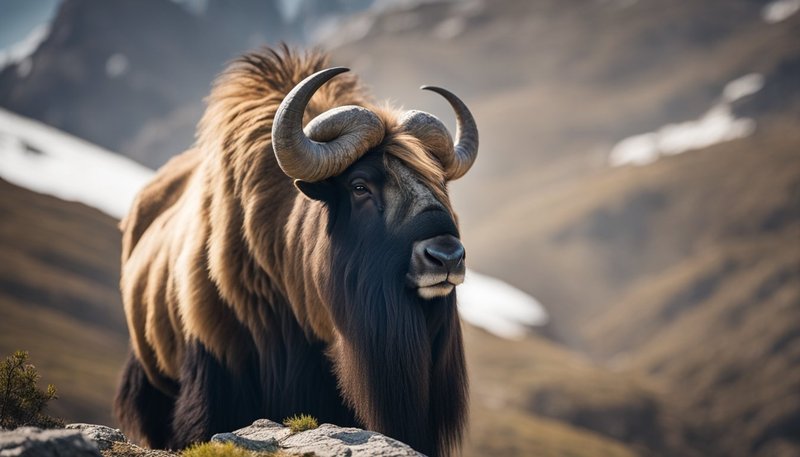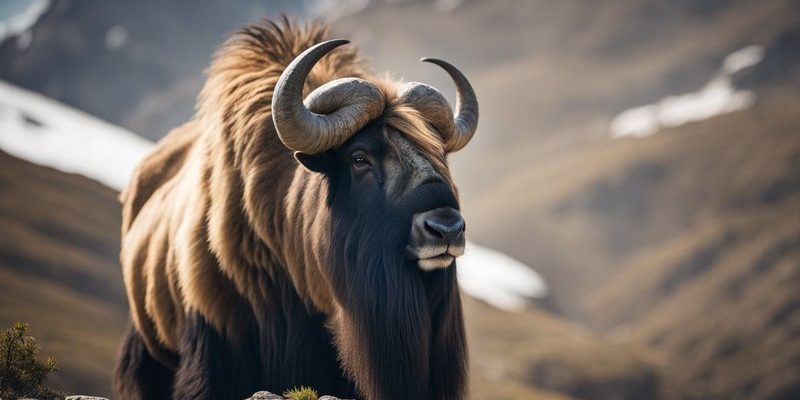
Let me explain. Many people have misconceptions about the takin, from its diet to its habitat. Some might even think it belongs to the goat family, but that’s not the whole story. As we dive into the myths and facts surrounding this remarkable animal, we’ll clear up the fog of misunderstanding and perhaps pique your interest in wildlife you may not have considered before.
The Takin’s Classification: Goat or Not?
One of the biggest myths about the takin is that it’s part of the goat family. In reality, the takin belongs to its own genus, called *Budorcas*. While it does share some characteristics with goats, like its stocky body and sure-footedness, it’s more closely related to the antelope family. Imagine them as distant cousins at a family reunion, sharing some traits but separated by branches on the family tree.
Despite their goat-like appearance, takins have several unique features. For instance, they have a broad, flat face and large, curved horns that can grow up to 30 inches long. These adaptations make them well-suited to their rugged, mountainous habitats. So, while they might look like goats to the untrained eye, they are truly one-of-a-kind creatures.
You might be wondering what this means for their behavior and lifestyle. Unlike goats, takins are social animals that often form small herds. These herds can be a crucial aspect of their survival, as they offer protection from predators and help them find food together. So, while they may seem similar to goats, their social structure and classification tell a different story.
Diet and Eating Habits: Grazers or Browsers?
Another common misconception is about the takin’s eating habits. Many people assume that these animals are strict grazers, munching on grass like a cow. While they do enjoy grazing, takins are primarily browsers. This means they prefer to eat leaves, shrubs, and twigs from trees. Imagine them as the picky eaters of the animal world, carefully selecting their meals from the best parts of plants.
In the wild, takins can be found in dense forests, where they can easily reach the upper foliage. They have powerful jaws and teeth that help them strip leaves from branches. This browsing behavior plays an essential role in their ecosystem, as they help keep plant growth in check and ensure that certain species don’t become too dominant.
Feeding time can be quite a sight! Takins often use their impressive sense of smell to locate food, even beneath layers of snow. Picture them navigating the snowy mountains, a bit like a chef searching for the finest ingredients in a winter wonderland. It’s fascinating how their diet influences their habitat and behavior.
Habitat Myths: Where Do Takins Live?
You may have heard that takins are exclusive to specific regions of Asia. While they are primarily found in the Himalayas and the eastern parts of the continent, this myth overlooks their adaptability. Takins can thrive in various environments—from dense forests to open grasslands. They prefer rugged terrains but can also adjust to different altitudes.
These hardy animals are often spotted at elevations of 2,500 to 4,500 meters (about 8,200 to 14,800 feet). Their thick fur and layer of fat help them survive the harsh weather conditions of their mountainous homes. Think of them as the ultimate mountain adventurers, equipped with nature’s own winter gear.
Interestingly, the presence of takins in a specific area can signal a healthy ecosystem. Their foraging habits lead to the growth of diverse plant life, which in turn supports other wildlife. So, if you ever find yourself hiking in the mountains of Bhutan or China, keep your eyes peeled—there’s a good chance you might spot these incredible creatures!
Conservation Status: Are Takins Endangered?
Another myth that often surfaces is whether takins are endangered. While they do face threats from habitat loss and hunting, they are classified as “Near Threatened” rather than endangered. This status means that while their numbers are decreasing, they are not at immediate risk of extinction like some other species.
Conservation efforts are in place in several countries to protect the takin. National parks and reserves serve as safe havens where these animals can thrive with minimal human interference. Think of these protected areas as the takin’s very own VIP sections—safe, secure, and just for them!
However, challenges remain. Poaching and habitat destruction still pose significant risks. It’s vital for local communities and conservationists to work together to ensure that this magnificent animal continues to roam the mountains for generations to come. If you’re passionate about wildlife, supporting conservation initiatives can make a real difference.
Behavioral Myths: Are Takins Aggressive?
When you look at a takin, you might wonder if they’re aggressive, especially with those impressive horns. The truth is, takins are generally quite gentle creatures. While they can defend themselves if threatened, their first instinct is usually to flee rather than fight. This non-aggressive nature helps them maintain their social group and avoid confrontation.
In the wild, takins are known for their friendly disposition within their herds. They nurture their young and often groom each other, which strengthens their bonds. Imagine a group of friends hanging out and supporting each other—that’s the takin community in action!
Occasionally, you might see some playful behavior, especially among younger takins. They engage in sparring matches that resemble play-fighting, practicing their skills without any real aggression. This friendly competition helps them build strength and learn about social hierarchies, which is key to their survival.
Physical Characteristics: Myths About Their Size
Another widely held belief is about the size of takins. People sometimes assume they’re small, maybe comparable to a deer. In reality, takins are quite large, weighing between 220 to 450 pounds (100 to 200 kg). They can stand about 4 to 6 feet tall at the shoulder. That’s a hefty animal by any standard!
The takin’s size and build are adaptations to their mountain habitats. Their robust bodies and thick legs help them navigate steep, rocky terrain. Just picture them scaling cliffs effortlessly, much like a well-trained athlete. Their unique structure helps them survive in harsh weather, making them true mountain dwellers.
Interestingly, females are generally smaller than males, which is a typical pattern in many animal species. This sexual dimorphism often leads to fascinating behaviors in their social groups, where males might showcase themselves to attract females. It’s like a natural version of a talent show, where only the best get the chance to mate.
Understanding the takin isn’t just about learning facts; it’s about appreciating the richness of our planet’s diversity. This remarkable animal is often misunderstood, and breaking down these myths helps us see them for what they truly are—unique, adaptable, and crucial members of their ecosystem.
So, next time you hear someone talking about takins, you can jump in with confidence and share these insights. Whether they’re discussing their diet, habitat, or behavior, you’ll be equipped to enlighten and inspire curiosity about this fascinating creature. After all, the world is full of amazing animals waiting to be discovered, and every bit of knowledge brings us closer to protecting them.
Remember, every time we learn more about wildlife like the takin, we help foster a connection to nature that is vital for conservation. Let’s keep exploring together!

